Adam Yamey's Blog: YAMEY, page 79
August 20, 2023
A magnificent shopping arcade in Nottingham
DURING A BRIEF VISIT to Nottingham made especially to view the centrally located Nottingham Contemporary art gallery (opened 2009), we spent a few minutes looking at some of the fine old buildings nearby. One of these is a shopping mall or arcade that reminded me a little of the superb Galleria Vittorio Emanuele II in Milan (Italy). Not as big as the structure in Milan, Nottingham’s Exchange Arcade is surprisingly grand.
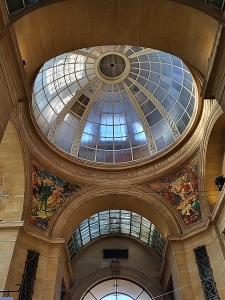
Built between 1927 and 1929, it was part of a major civic construction project, which included the nearby Council House. It was opened by the then Prince of Wales, who became King Edward VIII briefly before abdicating to marry Wallace Simpson.
Shops in the Exchange are arranged along a long central corridor and two shorter side corridors. Together, these wide walkways make a ‘T’ shape. Where the long corridor meets the two shorter ones is beneath a glazed dome. The dome is supported by four sloping walls, upon each of which there is a colourful fresco. One of these depicts a local hero, Robin Hood, firing his bow and arrow.
When it first opened, the Exchange housed Joseph Burton’s emporium, Nottingham’s version of London’s Fortnum & Mason. By the early 1980s, the arcade had become shabby, and was renovated. Now, it contains 17 retail stores. Although I am pleased that we saw the Nottingham Contemporary, I am glad we also managed to visit the magnificent Exchange arcade.
August 19, 2023
What a relief after watching Barbie
AFTER WATCHING THE film “Barbie”, which I did not enjoy and even bored me at times, we walked west from the Genesis Cinema along Mile End Road towards Whitechapel Underground station. On our way, we passed Trinity Green, which is surrounded by the picturesque Trinity Green Almshouses (‘TGA’).
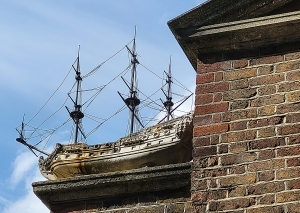
Probably the second oldest surviving almshouses in London, the TGA was built in 1695 by the Corporation of Trinity House. The oldest is The Charterhouse. The purpose of the TGA was to provide housing for poor captains and ship’s masters, and/or their widows. In about 1895, the TGA was threatened with demolition, but saved by a public campaign to preserve them. The buildings were the first to be placed on a preservation register, the forerunner of the ‘listed buildings’ system that protects historic structures from alteration or demolition.
Buildings that flank the two sides of the entrance gate are adorned with sculptures of sailing vessels, complete with masts and rigging. On each of the gatehouses, there are plaques recording the fact that the TGA was built in 1695 on land donated by Henry Mudd of Rattcliff and his widowed sister-in-law. At the end of the rectangular lawn that is surrounded by the dwelling units, there is a chapel, Sadly, the compound was locked up and could only be viewed from the street. It appears that people are still living there.
Seeing the beautiful, nay elegant, TGA was a great relief after having subjected ourselves (voluntarily) to a film, chock full of unsubtle sophomoric (‘sixth or even fifth form’) messages, which many of our intelligent friends have enjoyed greatly. Maybe, we missed something that endeared the film to them. The one good thing I have to say about the film is that I am certain that its box office takings will help keep cinemas we like, including Genesis, in business after the disastrous years of the pandemic.
August 18, 2023
Blowing in Bermondsey
IT IS UNNECESSARY to travel from London to Venice to see masterpieces of glass bowing. You need only make your way to Bermondsey Street in south London where you will find London Glassblowing. It is both a gallery and workshop set up by Peter Layton, who is now over 80 years old and still creating beautiful artefacts. Layton was born in Prague and grew up in England. After studying ceramics at London’s Central School of Art and Design, he taught ceramics at the University of Iowa in the USA. It was there that he discovered glass blowing and took to it. When he returned to England in 1976, he established his London Glassblowing in London. It has been located at its present address for about 15 years. Before that, he was in Leather Yard. Apart from creating works of art in glass, he also teaches and mentors other glass blowers.
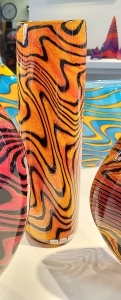
Whenever we visit Bermondsey Street, we make a point of visiting Layton’s establishment. Always the works on display are both beautiful and highly inventive. Occasionally, if we reach the place at the right time, we can watch glass blowers at work in the invariably hot workshop behind the gallery. Unlike the workshops we have visited on the island of Murano (near Venice), the works produced in Bermondsey Street – both sculptural and functional – are tastefully contemporary and often avant-garde.
August 17, 2023
Anselm Kiefer at the White Cube in Bermondsey
TODAY, I MADE MY second visit to the Anselm Kiefer exhibition, which is on at the Bermondsey White Cube gallery until the 20th of August 2023. I was pleased to visit it again because after my first visit, I left it feeling oppressed and somewhat depressed. This might be what the artist (born at the end of WW2 in Germany) intended when he created the extraordinary series of scenes of dereliction and decay on show in Bermondsey. My second visit (on the 15th of August 2023) left me with a slightly more favourable impression, but my opinion that the artist has depicted an image of a world of confusion, conflict, and decay, remains unchanged.

The works, which are distributed in several rooms and the central corridor of the gallery, are, so I read in an information sheet, Kiefer’s reactions to, and representation of, a novel by James Joyce – “Finnegan’s Wake”. The artist has written short quotations from the book on many of the items that together make up the amazing art installations. As I have not read the book, I cannot comment on the appropriateness of what he has created.
In one room of the gallery, there are mainly huge paintings, which I found attractive. On close examination, one can see that the paint has been applied to that it is far from flat. The three-dimensional surfaces create interesting illusions, which change according to from where you view the pictures.
Another room has a huge pile of sand littered with discarded, corroded supermarket trolleys – an impressive but sad sight. In yet another room, most of the floor is covered with barbed wire and huge pieces of concrete – the ruins of a large building. As a friend of ours said, it looked as if it had been imported straight from a bombsite in Ukraine.
Would I recommend visiting this exhibition? It is certainly inappropriate for people who suffer from claustrophobia or depression. However, if you are of an adventurous frame of mind, do head for this show before it ends.
August 16, 2023
A movable gallows in Rutland
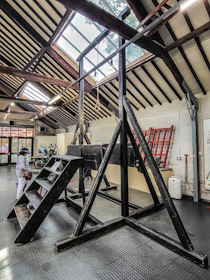
IN YEARS GONE BY, punishment by hanging was not a rare occurrence. The museum in Oakham, the capital of Rutland county, includes amongst its exhibits a mobile gibbet. This apparatus for hanging criminals is one of the few surviving movable gibbets (gallows) in Britain. When needed, it was moved from village to village. Unfortunately, it was designed badly. It had insufficient drop. This meant that the victim was strangled but not killed. I do not know what method was used to ‘finish off’ the unfortunate victims.
August 15, 2023
Impressions of India in preparation
At the moment, I am preoccupied with carrying out the final editing of my latest book, which I have described briefly below. When I publish it, which I hope will be soon, I will post more about it here in my blog and elsewhere.
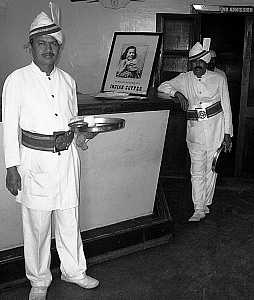
A lock made by Hitler; Bollywood encounters; jackals on the golf course; teamakers and politicians; banyans and monkeys; Gandhi’s optician; coracles and crocodiles; and Denmark in India: these are just a few of the topics covered in Adam Yamey’s collection of 101 intriguing vignettes of life in India. This book with illustrations is the author’s love letter to India, a country he has been visiting frequently for almost 30 years.
August 14, 2023
What shall it be?
He invited her home. After entering, he said to her:
“What will it be? Gin and platonic, or whisky and sofa?”
My witty late father-in-law told me this many years ago.
August 13, 2023
So many horse shoes on the wall in Oakham Castle
WHEN I WAS a child, I used to enjoy leafing through a book filled with black and white photographs of places in all the counties of England. One of them that stuck in my mind was of a wall covered with large horseshoes. It was only today (the 11th of August 2023) that I saw this wall in ‘real life’. It is in the great hall of Oakham Castle in England’s smallest county – Rutland. The hall, a fine example of Norman architecture, was built between about 1180 and 1190 for one of William the Conqueror’s grandsons – Walkelin de Ferrers. The name ‘Ferrers’ is related to the French word for iron and the English word ‘farrier’, who applies shoes to horse’s hooves.
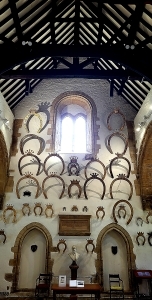
The Ferrers family held Oakham for about 130 years. It might have been during that time, or certainly by the early 16th century that a curious tradition was established. It was decreed that every peer of the realm who visits Oakham for the first time must donate a horseshoe to the lord of the manor. That tradition is continued even today. Some 245 larger than life horseshoes have been donated to Oakham and many of them can be seen within the great hall. It is likely that others were donated, and subsequently lost. Most of the horseshoes on display bear the names of the donors and the date when they were donated – that is, the year the donor first visited Oakham.
Three of the horseshoes all bear the date 1921, which was when their donors (the future King Edward VIII, the future King George VI, and Princess Mary – daughter of King George V) all visited Rutland as part of a hunting party. Also in 1921, Oakham was visited by Frederick Rudolph Lambart, 10th Earl of Cavan. In 1917, he took command of the British forces in Italy. His horseshoe is mounted on a wooden board. It surrounds a real horseshoe, which had once been worn by an Austrian pony, which he captured after a raid on enemy trenches in Asiago. Another visitor to Oakham was William Edwardes, 3rd Baron of Kensington, after whom Edwardes Square (in Kensington) was named. He visited in 1855. One could continue, but I will not because the biographies of the illustrious donors are too numerous to describe in this short essay.
Another special feature of the great hall is that it is still a working Crown Court. It is used occasionally. Of all the Crown Courts in England, this has remained housed in its original building longer than any others in the country.
Apart from the fascinating great hall, the tiny town of Oakham has many other interesting things to see including a market cross, a fine museum, a gothic parish church, and Oakham School (founded 1584). However, the hall full of horseshoes is by far the most interesting thing to visit. I was pleased to see it even if so many decades have elapsed since I saw a photograph of it during my childhood.
August 12, 2023
Mile stone
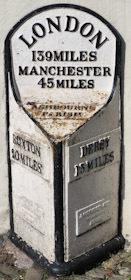 Ashbourne, Derbyshire
Ashbourne, Derbyshire Many miles to go
This stone is going nowhere
So it seems to me
August 11, 2023
Was she truly naked in her horse?
LADY GODIVA WHO died sometime in the second half of the 11th century (AD), has often been depicted by artists as riding nude through the city of Coventry. She was an Anglo-Saxon aristocrat, who was married to Leofric Earl of Mercia.
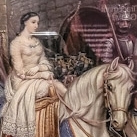
According to legend, she made her famous horse ride through Coventry to protest against excessive taxation that her husband had imposed on the people.
Most artists have portrayed her as being totally nude, thus producing images or sculptures with some pornographic content.
The Herbert Art Gallery in Coventry has a small gallery dedicated to Godiva. Most of the artworks on display show her without any clothing. However, one painting shows her on her horse but wearing plain, unrevealing simple garments. This is most likely how Lady Godiva was dressed on her ride. The reason is that penitents used to wear unadorned undergarments when processing in public. It is most likely that Godiva, who would have normally worn fancy clothing and jewellery, rode through the city devoid of these trappings of wealth and position – this would have been described as ‘naked’.
Our short visit to the Godiva exhibit was most interesting because it opened our eyes to another interpretation of Lady Godiva and her protest.



